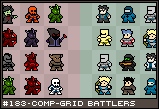| Three Hundred |
| - Index Page |
| - About... |
| - By Year |
| Collections |
| - Comp-Grid |
| - Procedural |
| - Tactics |
| - Tiny Crawl |
| - Misc |
| Previous | Mechanic #183 | Next |
![[fantasy1.png]](set10/img/entry183-fantasy1.png)
I'm going to be completely upfront about my inspiration here. I was watching GameTrailer's Top 10 Worst Final Fantasy Games video and when I saw #1, Final Fantasy: All the Bravest, I was like, "No way! That game looks amazing!". A little research later and I discover that the game I saw in my head was WAY more interesting than reality (and less likely to be won by rubbing your face all over your iPad). So, what I'm going to do is present the game I saw in my head in that very instant when I first viewed the game. Because, sometimes, my brain invents new games automatically.
![[grid1.png]](set10/img/entry183-grid1.png)
This is a battle between two armies. In true composition grid fashion, you build your army by picking the units and their positions. And of course, where the units are, both in relation to each other and to the grid itself, matters. After a unit is activated, there is a short period of time in which they are recharging and can not be used again. The most basic way that you interact with your units is by tapping on them. This is an "activate" action, and what happens depends on the unit. A melee unit may jump forward an attack a random enemy with a sword, while a cleric could heal the neighboring units, or a mage could cast a fireball spell. The position on the grid matters. Melee units will only attack enemies in the same row and archers have a limited range based on the column they are in. Some units, like thieves, have different behaviors based on the column they are in. In the front column, they rush forward and attack. In the second and third column, they throw knives at the enemy. In the fourth and final column, they'll disappear for a while, only to reappear behind an enemy to backstab them.
![[grid2.gif]](set10/img/entry183-grid2.gif)
You can shift each column vertically by swiping your finger up or down. This will change units' rows, but their columns will remain the same. You can shift units even if they are still recharging.
![[grid3.gif]](set10/img/entry183-grid3.gif)
You can instigate a "charge" action by swiping your finger along a row towards the enemy. This will cause the entire row (which must be recharged and active) to rush forward towards the enemy. This is where the game's main combo mechanism is, as each unit will perform a different charge effect based on type. A warrior might do damage, but a cleric causes the next 3 rush hits to double in power, or a fire mage could set the enemy on fire for the rush, causing each additional hit to cause fire damage. Shift your units around to create rush combos. Finally, some units have an automatic action that is triggered when their recharge is finished, usually with an eye towards temporary buffs. A cleric could heal its row when it recharges, while a warrior may buff neighboring units when it recharges. There is time, during the recharge, to shift the units around so that their automatic actions are triggered in an optimal position.
|
